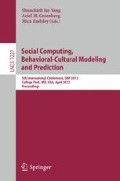Abstract
This paper presents a socio-technical study on how humans collectively perceive trustworthiness in a suspicious situation when evoked by computer-mediated communications (CMC). This research was designed through the use of an online game, entitled ”Whodunit” to study how collective trust in a virtual scenario can be reflected in untrustworthy cloud environments. We propose that virtual dialogue can provide important clues to understanding an actor’s inclination, using the cognitive process of observers’ collective trust in a virtual collaborative group. The methodology proposed in this paper is built on research that demonstrates how human “sensors” can detect unusual or unexpected changes in a psychological construct: trustworthiness – based on observed virtual behavior. The research framework adopts the theory of trustworthiness attribution to model collective trust in virtual interactive environments. Humans “sensors,” with limited access to information (e.g., online conversations) make assessments based on subtle observed changes to a person’s disposition. This paper concludes that people that rely on “cognitive trust” can identify dispositional changes within untrustworthy scenarios more precisely than people that rely on “emotional trust.” In addition, people who have a propensity to trust others more than themselves (lacking confidence in their own abilities) tend to do better identifying the correct murderer.
Access this chapter
Tax calculation will be finalised at checkout
Purchases are for personal use only
Preview
Unable to display preview. Download preview PDF.
References
Ho, S.M.: Attribution-Based Anomaly Detection: Trustworthiness in an Online Community. In: Liu, H., Salerno, J.J., Young, M.J. (eds.) Social Computing, Behavioral Modeling, pp. 129–140. Springer, Tempe (2008)
Ho, S.M.: A Socio-Technical Approach to Understanding Perceptions of Trustworthiness in Virtual Organizations. In: Liu, H., Salerno, J.J., Young, M.J. (eds.) Social Computing and Behavioral Modeling, pp. 1–10. Springer, Tempe (2009)
Lewis, J.D., Wrigert, A.: Trust as a Social Reality. Social Forces 63(4), 967–985 (1985)
McEvily, B., et al.: Can groups be trusted? An experimental study of collective trust, Carnegie Mellon University Department of Social and Decision Sciences (2002)
Hardin, R.: Gaming Trust. In: Ostrom, E., Walker, J. (eds.) Trust and Reciprocity: Interdisciplinary Lessons From Experimental Research, pp. 80–101. Russell Sage Foundation, New York (2003)
Ho, S.M.: Behavioral Anomaly Detection: A Socio-Technical Study of Trustworthiness in Virtual Organizations. In: School of Information Studies 2009, p. 437. Syracuse University, Syracuse (2009)
Hosmer, L.T.: Trust: The Connecting Link Between Organizational Theory and Philosophical Ethics. Academy of Management Review 20(2), 379–403 (1995)
Rotter, J.B.: Interpersonal Trust, Trustworthiness and Gullibility. American Psychologist 35(1), 1–7 (1980)
Rotter, J.B., Stein, D.K.: Public Attitudes Toward the Trustworthiness, Competence, and Altruism of Twenty Selected Occupations. Journal of Applied Social Psychology 1(4), 334–343 (1971)
Tyler, T.R.: What is Procedural Justice? Law and Society Review 22, 301–355 (1988)
Tyler, T.R., Degoey, P.: Trust in Organizational Authorities: The Influence of Motive Attributions on Willingness to Accept Decisions. In: Kramer, R.M., Tyler, T.R. (eds.) Trust in Organizations: Frontiers of Theory and Research, pp. 331–356. Sage, Thousand Oaks (1996)
Mayer, R.C., Davis, J.H., Schoorman, F.D.: An Integrative Model of Organizational Trust. Academy of Management Review 20(3), 709–734 (1995)
Mayer, R.C., Davis, J.H.: The Effect of the Performance Appraisal System on Trust for Management: A Field Quasi-Experiment. Journal of Applied Psychology 84(1), 123–136 (1999)
Heider, F.: Social Perception and Phenomenal Causality. Psychological Review 51, 358–374 (1944)
Heider, F.: The Psychology of Interpersonal Relations. John Wiley & Sons, New York (1958)
Ajzen, I.: The Theory of Planned Behavior. Organizational Behavior and Human Decision Processes 50(2), 179–211 (1991)
Beck, L., Ajzen, I.: Predicting Dishonest Actions Using the Theory of Planned Behavior. Journal of Research in Personality 25(3), 285–301 (1991)
Holmes, J.G., Rempel, J.K.: Trust in Close Relationships. In: Hendrick, C. (ed.) Review of Personality and Social Psychology. Sage, Beverly Hills (1989a)
Rempel, J.K., Holmes, J.G., Zanba, M.D.: Trust in Close Relationship. Journal of Personality and Social Psychology 49, 95–112 (1985)
Bigley, G.A., Pearce, J.L.: Straining for shared meaning in organizational science: Problems of trust and distrust. Academy of Management Review 23(3), 405–421 (1998)
Kelley, H.H., et al.: The Process of Causal Attribution. American Psychology 28(2), 107–128 (1973)
von Ahn, L.: Games with a Purpose. IEEE Computer Magazine, 96–98 (2006)
von Ahn, L., Dabbish, L.: General Techniques for Designing Games with a Purpose. Communications of the ACM, 58–67 (2008)
von Ahn, L., et al.: reCAPTCHA: Human-based Character Recognition via Web Security Measures. Science, 1465–1468 (2008)
Author information
Authors and Affiliations
Editor information
Editors and Affiliations
Rights and permissions
Copyright information
© 2012 Springer-Verlag Berlin Heidelberg
About this paper
Cite this paper
Ho, S.M., Ahmed, I., Salome, R. (2012). Whodunit? Collective Trust in Virtual Interactions. In: Yang, S.J., Greenberg, A.M., Endsley, M. (eds) Social Computing, Behavioral - Cultural Modeling and Prediction. SBP 2012. Lecture Notes in Computer Science, vol 7227. Springer, Berlin, Heidelberg. https://doi.org/10.1007/978-3-642-29047-3_42
Download citation
DOI: https://doi.org/10.1007/978-3-642-29047-3_42
Publisher Name: Springer, Berlin, Heidelberg
Print ISBN: 978-3-642-29046-6
Online ISBN: 978-3-642-29047-3
eBook Packages: Computer ScienceComputer Science (R0)

